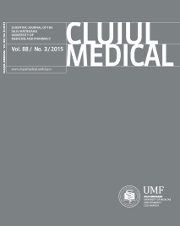Micro-CT and histological analysis of Ti6Al7Nb custom made implants with hydroxyapatite and SiO2-TiO2 coatings in a rabbit model
DOI:
https://doi.org/10.15386/cjmed-479Keywords:
micro-CT, Ti6Al7Nb, SLM, osseointegration, implant coating, custom made implantAbstract
Background and aim. Bone defect reconstruction in the maxillofacial area comes as a necessity after traumatic, oncological or congenital pathology. Custom made implant manufacturing, such as selective laser melting (SLM), is very helpful when bone reconstruction is needed. In the present study we assessed the osseointegration of custom made implants made of Ti6Al7Nb with two different coatings: SiO2-TiO2 and hydroxyapatite, by comparing the bone mineral density (BMD) measured on micro-CT and the histological mineralized bone surrounding the implants.
Methods. Custom made – cylindrical type – implants were produced by selective laser melting, coated with SiO2-TiO2 and hydroxyapatite and implanted in the rabbit femur. The animals (divided into 3 groups) were sacrificed at 1, 3 and 6 months and the implants were removed together with the surrounding bone. Bone mineral density and histological examination of the bone-implant surface was performed for each group.
Results. BMD and histological examination of the samples determined the quantity of mineralized bone at the implant site, showing a good percentage of mineralized bone for the coated implants at 1, 3 and 6 months, The measurements for the implants without coating showed a significant lower quantity of mineralized bone at 3 months compared with the implants with coating, and a good quantity of mineralized bone at 6 months, showing a process of demineralization followed by remineralization in the last month. The measurements of BMD showed similar results with the histological examination.
Conclusions. The use of micro-CT and the measurement of BMD are a reliable, minimally invasive and a quick method of osseointegration assessment.
Downloads
Additional Files
Published
How to Cite
Issue
Section
License
The authors are required to transfer the copyright of the published paper to the journal. This is done by agreeing to sign the Copyright Assignment Form. Whenever the case, authors are also required to send permissions to reproduce material (such as illustrations) from the copyright holder.

The papers published in the journal are licensed under a Creative Commons Attribution-NonCommercial-NoDerivatives 4.0 International License.

